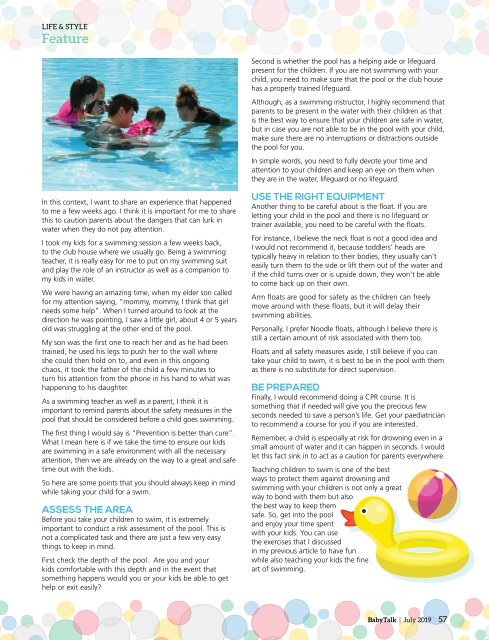Create successful ePaper yourself
Turn your PDF publications into a flip-book with our unique Google optimized e-Paper software.
Life & Style<br />
Feature<br />
Second is whether the pool has a helping aide or lifeguard<br />
present for the children. If you are not swimming with your<br />
child, you need to make sure that the pool or the club house<br />
has a properly trained lifeguard.<br />
Although, as a swimming instructor, I highly recommend that<br />
parents to be present in the water with their children as that<br />
is the best way to ensure that your children are safe in water,<br />
but in case you are not able to be in the pool with your child,<br />
make sure there are no interruptions or distractions outside<br />
the pool for you.<br />
In simple words, you need to fully devote your time and<br />
attention to your children and keep an eye on them when<br />
they are in the water, lifeguard or no lifeguard.<br />
In this context, I want to share an experience that happened<br />
to me a few weeks ago. I think it is important for me to share<br />
this to caution parents about the dangers that can lurk in<br />
water when they do not pay attention.<br />
I took my kids for a swimming session a few weeks back,<br />
to the club house where we usually go. Being a swimming<br />
teacher, it is really easy for me to put on my swimming suit<br />
and play the role of an instructor as well as a companion to<br />
my kids in water.<br />
We were having an amazing time, when my elder son called<br />
for my attention saying, “mommy, mommy, I think that girl<br />
needs some help”. When I turned around to look at the<br />
direction he was pointing, I saw a little girl, about 4 or 5 years<br />
old was struggling at the other end of the pool.<br />
My son was the first one to reach her and as he had been<br />
trained, he used his legs to push her to the wall where<br />
she could then hold on to, and even in this ongoing<br />
chaos, it took the father of the child a few minutes to<br />
turn his attention from the phone in his hand to what was<br />
happening to his daughter.<br />
As a swimming teacher as well as a parent, I think it is<br />
important to remind parents about the safety measures in the<br />
pool that should be considered before a child goes swimming.<br />
The first thing I would say is “Prevention is better than cure”.<br />
What I mean here is if we take the time to ensure our kids<br />
are swimming in a safe environment with all the necessary<br />
attention, then we are already on the way to a great and safe<br />
time out with the kids.<br />
So here are some points that you should always keep in mind<br />
while taking your child for a swim.<br />
Assess the area<br />
Before you take your children to swim, it is extremely<br />
important to conduct a risk assessment of the pool. This is<br />
not a complicated task and there are just a few very easy<br />
things to keep in mind.<br />
First check the depth of the pool. Are you and your<br />
kids comfortable with this depth and in the event that<br />
something happens would you or your kids be able to get<br />
help or exit easily?<br />
Use the right equipment<br />
Another thing to be careful about is the float. If you are<br />
letting your child in the pool and there is no lifeguard or<br />
trainer available, you need to be careful with the floats.<br />
For instance, I believe the neck float is not a good idea and<br />
I would not recommend it, because toddlers’ heads are<br />
typically heavy in relation to their bodies, they usually can’t<br />
easily turn them to the side or lift them out of the water and<br />
if the child turns over or is upside down, they won’t be able<br />
to come back up on their own.<br />
Arm floats are good for safety as the children can freely<br />
move around with these floats, but it will delay their<br />
swimming abilities.<br />
Personally, I prefer Noodle floats, although I believe there is<br />
still a certain amount of risk associated with them too.<br />
Floats and all safety measures aside, I still believe if you can<br />
take your child to swim, it is best to be in the pool with them<br />
as there is no substitute for direct supervision.<br />
Be Prepared<br />
Finally, I would recommend doing a CPR course. It is<br />
something that if needed will give you the precious few<br />
seconds needed to save a person’s life. Get your paediatrician<br />
to recommend a course for you if you are interested.<br />
Remember, a child is especially at risk for drowning even in a<br />
small amount of water and it can happen in seconds. I would<br />
let this fact sink in to act as a caution for parents everywhere.<br />
Teaching children to swim is one of the best<br />
ways to protect them against drowning and<br />
swimming with your children is not only a great<br />
way to bond with them but also<br />
the best way to keep them<br />
safe. So, get into the pool<br />
and enjoy your time spent<br />
with your kids. You can use<br />
the exercises that I discussed<br />
in my previous article to have fun<br />
while also teaching your kids the fine<br />
art of swimming.<br />
BabyTalk | <strong>July</strong> <strong>2019</strong> 57

















